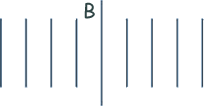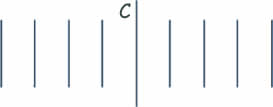Diffraction - Multiple Choice Questions
Q1
Monochromatic light of wavelength 590 nm is incident normally on a plane diffraction grating having 4 × 105 lines m−1 . An interference pattern is produced.
What is the highest order visible in this interference pattern?
Q2
Light of wavelength λ is incident normally on a diffraction grating of slit separation 4λ.
What is the angle between the second order maximum and third order maximum?
A |
14.5° |
B |
18.6° |
C |
48.6° |
D |
71.4° |
Q3.
Monochromatic light of wavelength 490 nm falls normally on a diffraction grating that has 6 × 105 lines per metre.
Which one of the following is correct?
A |
The first order is observed at angle of diffraction of 17°. |
B |
The second order is observed at angle of diffraction of 34°. |
C |
The third and higher orders are not produced. |
D |
A grating with more lines per metre could produce more orders. |
Q4.
Light of wavelength λ is incident normally on a diffraction grating for which adjacent lines are a distance 3λ apart. What is the angle between the second order maximum and the straight-through position?
| A |
9.6° |
| B |
20° |
| C |
42° |
| D |
There is no second order maximum. |
Q5.
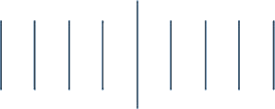
The diagram above shows the first four diffraction orders each side of the zero order when a beam of monochromatic light is incident normally on a diffraction grating of slit separation d.
All the angles of diffraction are small.
The grating is then exchanged for one with a slit separation d/2
Select the diffraction orders now observed from the patterns, A to D, drawn below.
The diagrams are drawn on the same scale as the graphic above.
Q6.
A light source emits light which is a mixture of two wavelength, λ1 and λ2.
When the light is incident on a diffraction grating it is found that the fifth order of light of wavelength λ1 occurs at the same angle as the fourth order for light of wavelength λ2.
If λ1 is 480 nm what is λ2?
A |
400 nm |
B |
480 nm |
C |
600 nm |
D |
750 nm |
Q7.
A diffraction pattern is formed by passing monochromatic light through a single slit. If the width of the single slit is reduced, which of the following is true?
|
Width of central
maximum |
Intensity of central
maximum |
A |
unchanged |
decreases |
B |
increases |
increases |
C |
increases |
decreases |
D |
decreases |
decreases |
Q8. Light of wavelength λ passes through a diffraction grating with slit spacing d. A series of lines (fringe pattern) is observed on a screen.
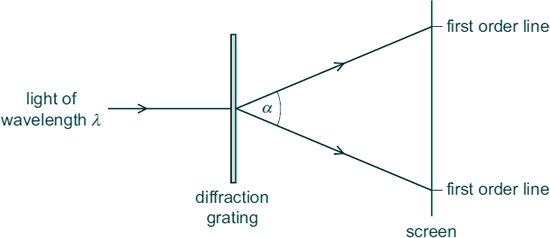
What is the angle α between the two first order lines?
A |
sin-1( λ/2d ) |
B |
sin-1( λ/d ) |
C |
2sin-1( λ/2d ) |
D |
2sin-1( λ/d ) |
Q9.
A diffraction grating experiment is set up using yellow light of wavelength 600nm.
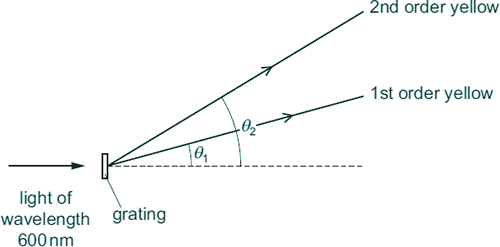
The grating has a slit separation of 2.00 μm.
What is the angular separation (θ2 – θ1) between the first and second order maxima of the yellow light?
A |
17.5° |
B |
19.4° |
C |
36.9° |
D |
54.3° |
Q10.
A wave is diffracted as it passes through an opening in a barrier.
The amount of diffraction that the wave undergoes depends on both the:
A |
amplitude and frequency of the incident wave. |
B |
wavelength and amplitude of the incident wave. |
C |
wavelength of the incident wave and the size of the opening. |
D |
amplitude of the incident wave and the size of the opening. |
Q11. Which of the following provides evidence that light has a wave nature?
A |
The emission of light from an energy-level transition in a hydrogen atom. |
B |
The diffraction of light passing through a narrow opening. |
C |
The absorption of ultra-violet radiation in the photoelectric effect. |
D |
The reflection of light from a mirror |
Q12. In a diffraction-grating experiment the maxima are produced on a screen.
What causes the separation of the maxima of the diffraction pattern to decrease?
A |
using light with a longer wavelength |
B |
increasing the distance between the screen and grating |
C |
increasing the distance between the source and grating |
D |
using a grating with a greater slit separation |
Q13. Two waves with amplitudes a and 3a interfere.
The ratio of (amplitude at interference maximim)/(amplitude at interference minimum) is:
Q14. White light passes through a single narrow slit and illuminates a screen.
What is observed on the screen?
A |
a set of equally spaced white fringes |
B |
a central maximum made up of a spectrum surrounded by white fringes |
C |
a white central maximum surrounded by coloured fringes |
D |
a single narrow white line |
Q15. When light of wavelength 5.0 × 10−7 m is incident normally on a diffraction grating the fourth-order maximum is observed at an angle of 30°.
What is the number of lines per mm on the diffraction grating?
A |
2.5 × 102 |
B |
2.5 × 105 |
C |
1.0 × 103 |
D |
1.0 × 106 |
Q16. Intensity maxima are produced on a screen when a parallel beam of monochromatic light is incident on a diffraction grating.
Light of a longer wavelength can be used or the distance from the diffraction grating to the screen can be increased.
Which row gives the change in appearance of the maxima when these changes are made independently?
| |
Longer wavelength |
Distance from grating to screen increased |
A |
closer together |
more widely spaced |
B |
more widely spaced |
more widely spaced |
C |
more widely spaced |
closer together |
D |
closer together |
closer together |
Q17. Light of wavelength 500 nm is passed through a diffraction grating which has 400 lines per mm.
What is the angular separation between the two second-order maxima?
A |
11.5° |
B |
23.1° |
C |
23.6° |
D |
47.2° |






